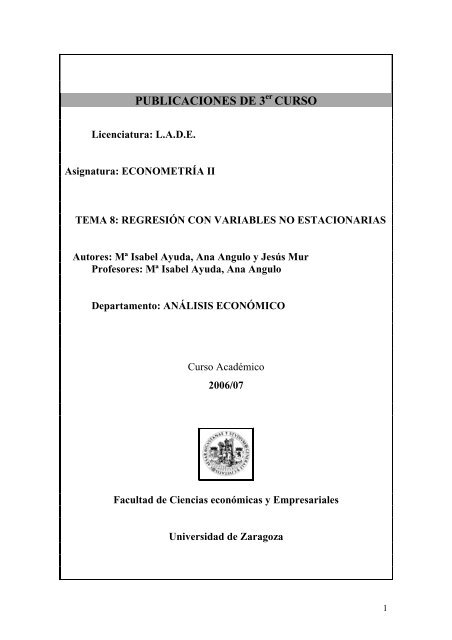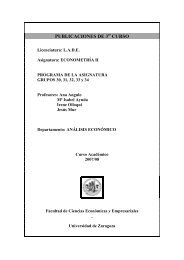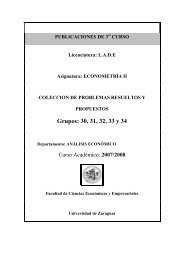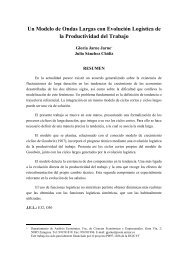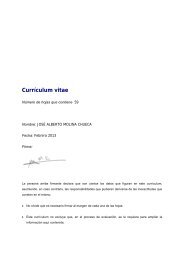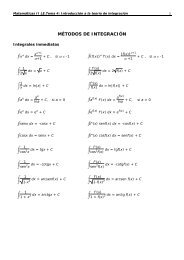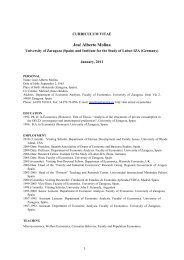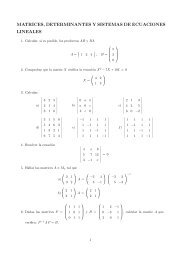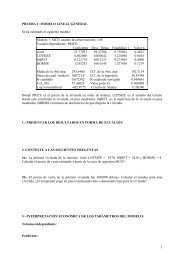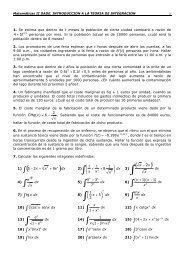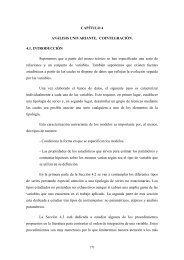tema 8:regresión con variables no estacionarias - Departamento de ...
tema 8:regresión con variables no estacionarias - Departamento de ...
tema 8:regresión con variables no estacionarias - Departamento de ...
You also want an ePaper? Increase the reach of your titles
YUMPU automatically turns print PDFs into web optimized ePapers that Google loves.
PUBLICACIONES DE 3 er CURSO<br />
Licenciatura: L.A.D.E.<br />
Asignatura: ECONOMETRÍA II<br />
TEMA 8: REGRESIÓN CON VARIABLES NO ESTACIONARIAS<br />
Autores: Mª Isabel Ayuda, Ana Angulo y Jesús Mur<br />
Profesores: Mª Isabel Ayuda, Ana Angulo<br />
<strong>Departamento</strong>: ANÁLISIS ECONÓMICO<br />
Curso Académico<br />
2006/07<br />
Facultad <strong>de</strong> Ciencias e<strong>con</strong>ómicas y Empresariales<br />
Universidad <strong>de</strong> Zaragoza<br />
1
TEMA 8:<br />
REGRESIÓN CON VARIABLES NO ESTACIONARIAS<br />
1.- Introducción<br />
2.-Consecuencias <strong>de</strong> la <strong>no</strong> estacionariedad sobre la<br />
estimación MCO<br />
3.- Alternativas <strong>de</strong> especificación y estimación<br />
4.- Contrastes <strong>de</strong> raíces unitarias y cointegración<br />
2
1.- Introducción<br />
El que una variable presente sistemáticamente rachas <strong>de</strong><br />
valores por encima o por <strong>de</strong>bajo <strong>de</strong> la media indica la presencia<br />
<strong>de</strong> una RAIZ UNITARIA en la estructura estocástica <strong>de</strong> la<br />
variable y <strong>de</strong>cimos entonces que la serie <strong>no</strong> es estacionaria.<br />
vuelva.<br />
infinito.<br />
Las características <strong>de</strong> una serie <strong>no</strong> estacionaria son:<br />
a.- No hay una media a largo plazo a la cual la serie<br />
b.- Su varianza aumenta <strong>con</strong> el tiempo, tendiendo a<br />
c.- Un shock sobre el nivel <strong>de</strong> dicha serie produce un<br />
efecto permanente.<br />
lentamente.<br />
d.- Los valores <strong>de</strong> la función <strong>de</strong> autocorrelación <strong>de</strong>crecen<br />
3
Aunque en e<strong>con</strong>omía muchas series <strong>no</strong> son <strong>estacionarias</strong>,<br />
muestran una relación estable a lo largo <strong>de</strong>l tiempo, lo que sugiere<br />
una relación <strong>de</strong> equilibrio a largo plazo entre ellas.<br />
Si disponemos <strong>de</strong> dos <strong>variables</strong> (Xt, Yt) que son I(d) y existe<br />
una <strong>con</strong>stante a tal que la diferencia ( Yt<br />
− aX t ) es I(d-b) <strong>con</strong><br />
b>0, se dice que Xt e Yt están COINTEGRADAS <strong>de</strong> or<strong>de</strong>n (d,b).<br />
El caso más habitual es cuando Xt, Yt son I(1), pero<br />
− aX ) es estacionaria para una <strong>de</strong>terminada <strong>con</strong>stante a ,<br />
( Yt<br />
t<br />
entonces Xt<br />
e Yt están cointegradas <strong>de</strong> or<strong>de</strong>n (1,1) y se <strong>de</strong><strong>no</strong>ta<br />
CI(1,1), al vector α’ =(1, - a ) se le <strong>con</strong>oce como VECTOR DE<br />
COINTEGRACIÓN.<br />
4
2.- Consecuencias <strong>de</strong> la <strong>no</strong> estacionariedad en la<br />
estimación MCO.<br />
2.1.- Regresión espúrea o <strong>regresión</strong> <strong>con</strong> <strong>variables</strong> <strong>no</strong><br />
<strong>estacionarias</strong> y <strong>no</strong> cointegradas.<br />
• En regresiones <strong>con</strong> <strong>variables</strong> <strong>no</strong> <strong>estacionarias</strong> los<br />
estimadores son sesgados, <strong>no</strong> ELIO, <strong>no</strong> eficientes e<br />
in<strong>con</strong>sistentes.<br />
• Phillips (1987) <strong>de</strong>mostró que en una <strong>regresión</strong> <strong>con</strong><br />
<strong>variables</strong> <strong>no</strong> <strong>estacionarias</strong> el estadístico t, <strong>no</strong> se<br />
distribuye según una t-stu<strong>de</strong>nt y. El t-ratio tien<strong>de</strong> a<br />
infinito.<br />
5
2.2.- Variables <strong>no</strong> <strong>estacionarias</strong> y cointegradas<br />
• Si las series <strong>no</strong> <strong>estacionarias</strong> están cointegradas los<br />
estimadores MCO son super<strong>con</strong>sistentes, es <strong>de</strong>cir,<br />
<strong>con</strong>vergen al verda<strong>de</strong>ro valor <strong>de</strong>l parámetro mucho<br />
más rápidamente que en el caso habitual.<br />
• Sin embargo la inferencia estadística habitual carece<br />
<strong>de</strong> vali<strong>de</strong>z.<br />
6
3.- Alternativas <strong>de</strong> especificación y estimación<br />
1.- SERIES ESTACIONARIAS: Se especifica un mo<strong>de</strong>lo<br />
en niveles y se estima por los procedimientos habituales.<br />
2.- SERIES NO ESTACIONARIAS DE DISTINTO<br />
ORDEN: la ecuación <strong>de</strong> <strong>regresión</strong> carece <strong>de</strong> sentido.<br />
3.- SERIES NO ESTACIONARIAS Y NO<br />
COINTEGRADAS: Si dos series son integradas <strong>de</strong>l mismo or<strong>de</strong>n<br />
pero los residuos <strong>no</strong> son estacionarios, es el caso <strong>de</strong> <strong>regresión</strong><br />
espúrea. En tal caso se recomienda especificar un mo<strong>de</strong>lo en<br />
primeras diferencias y se estima por MCO.<br />
Δ y = βΔ<br />
x + u<br />
t<br />
4.- SERIES NO ESTACIONARIAS Y<br />
COINTEGRADAS: Si las dos <strong>variables</strong> son <strong>no</strong> <strong>estacionarias</strong>,<br />
integradas <strong>de</strong>l mismo or<strong>de</strong>n y los residuos <strong>de</strong> la <strong>regresión</strong> entre<br />
ambas son estacionarios, <strong>de</strong>cimos que están cointegradas. En<br />
dicho caso se especifica el mo<strong>de</strong>lo <strong>de</strong> Mecanismo <strong>de</strong> Corrección<br />
<strong>de</strong>l Error, MCE, (Engle y Granger (1987)).<br />
Δ t = Δxt<br />
−α<br />
( yt<br />
− 1 − β1<br />
− β2<br />
xt<br />
−1<br />
y γ ) + ε<br />
t<br />
t<br />
t<br />
7
Dentro <strong>de</strong>l paréntesis está el vector <strong>de</strong> cointegración o<br />
relación <strong>de</strong> equilibrio a largo plazo entre las <strong>variables</strong>.<br />
• El parámetro γ mi<strong>de</strong> el efecto a corto plazo que la<br />
variable xt tiene sobre yt.<br />
• El parámetro α es el parámetro <strong>de</strong> ajuste que explica<br />
como las <strong>variables</strong> en el corto plazo, reaccionan ante<br />
un cambio en la relación <strong>de</strong> equilibrio a largo plazo.<br />
• El parámetro β2 mi<strong>de</strong> el efecto a largo que la variable<br />
xt tiene sobre yt<br />
8
Métodos <strong>de</strong> estimación en el caso <strong>de</strong> <strong>variables</strong> <strong>no</strong><br />
<strong>estacionarias</strong> pero cointegradas:<br />
- Mínimos cuadrados <strong>no</strong> lineales, es el más a<strong>de</strong>cuado.<br />
- Procedimiento <strong>de</strong> Engle y Granger en dos etapas:<br />
• En la primera etapa se estima el vector <strong>de</strong><br />
cointegración a partir <strong>de</strong> lo valores <strong>con</strong>temporáneos<br />
<strong>de</strong> las <strong>variables</strong>. Al estar cointegrados, el residuo es<br />
estacionario.<br />
• En la segunda etapa se toman los residuos y se<br />
especifica el mo<strong>de</strong>lo <strong>de</strong> Mecanismo <strong>de</strong> Corrección<br />
<strong>de</strong>l error <strong>con</strong> los residuos retardados un periodo:<br />
Δ t = Δxt<br />
−αuˆ<br />
t −1<br />
y γ + ε<br />
INCONVENIENTES <strong>de</strong>l método en dos etapas:<br />
En la primera etapa la inferencia estadística habitual carece<br />
<strong>de</strong> vali<strong>de</strong>z si se estima por MCO.<br />
t<br />
9
4.-Contrastes <strong>de</strong> raíces unitarias y cointegración<br />
4.1.- Contrastes <strong>de</strong> raíz unitaria<br />
El análisis lo solventaremos en dos etapas:<br />
(a)- I<strong>de</strong>ntificación <strong>de</strong> la estructura <strong>de</strong>terminística <strong>de</strong> la<br />
serie.<br />
TRES CASOS DE INTERES<br />
M1: yt = vt<br />
M2: yt = δ + vt<br />
M3: y = δ + φt+<br />
v<br />
t t<br />
(b) I<strong>de</strong>ntificación <strong>de</strong> la estructura estocástica <strong>de</strong> la serie<br />
v ~ I( d )<br />
• CONTRASTES DE DICKEY-FULLER<br />
PGD ECUACION CONTRASTE<br />
M1: y = v Δ y = φ y + u<br />
v = φ v + u<br />
t<br />
t t t<br />
*<br />
1 t−1 t<br />
t 1 t−1 t<br />
M2: y = δ + v Δ y = δ + φ y + u<br />
v = φ v + u<br />
* *<br />
t t t 1 t−1 t<br />
t 1 t−1 t<br />
M 3: yt = δ + θt+ vt Δ yt * * *<br />
= δ + θ t+ φ1<br />
yt−1+<br />
u<br />
v = φ v + u<br />
t 1 t−1 t<br />
t<br />
10
En los tres mo<strong>de</strong>los la hipótesis nula a <strong>con</strong>trastar es la<br />
*<br />
misma H : φ = 0 NO ESTACIONARIEDAD<br />
0 1<br />
• CONTRASTE DE DICKEY-FULLER<br />
AUMENTADO<br />
Si hay problemas <strong>de</strong> autocorrelación en las ecuaciones <strong>de</strong><br />
<strong>con</strong>traste previas, se le aña<strong>de</strong> una estructura dinámica. Por<br />
ejemplo:<br />
PROBLEMAS:<br />
* * *<br />
p<br />
t 1 t 1<br />
i=<br />
1<br />
i<br />
Δ y = δ + θ t+ φ y − + ∑ Π Δ y − + ε<br />
• Son <strong>con</strong>trastes <strong>con</strong> una baja potencia.<br />
t i t<br />
• Incertidumbre <strong>con</strong> respecto al mo<strong>de</strong>lo más a<strong>de</strong>cuado. Los<br />
gráficos <strong>de</strong> la serie <strong>no</strong>s pue<strong>de</strong>n ayudar.<br />
11
4.2.- Contrastes <strong>de</strong> cointegración<br />
CONTRASTE DE ENGLE Y GRANGER<br />
Si tenemos Yt y Xt que son I(1) diremos que estas<br />
<strong>variables</strong> están cointegradas si :<br />
y ˆ ˆ<br />
t − β 1 − β2<br />
xt<br />
= uˆ<br />
t<br />
Para ello se estima la siguiente <strong>regresión</strong>:<br />
y <strong>con</strong>trastaremos H0:<br />
→<br />
p<br />
*<br />
t 1 t−1 ∑ i t−i i=<br />
1<br />
I<br />
( 0)<br />
Δ uˆ = φ uˆ + Π Δ uˆ + εt<br />
*<br />
φ 1 = 0 como la hipótesis alternativa es<br />
estacionariedad, diremos que las series están cointegradas si se<br />
rechaza la hipótesis nula.<br />
Los valores críticos <strong>de</strong>pen<strong>de</strong>n <strong>de</strong>l nivel <strong>de</strong> significación y<br />
<strong>de</strong>l número <strong>de</strong> <strong>variables</strong> incluídas en la <strong>regresión</strong> <strong>de</strong> cointegración<br />
(<strong>con</strong>tando <strong>con</strong> la endógena).<br />
12


